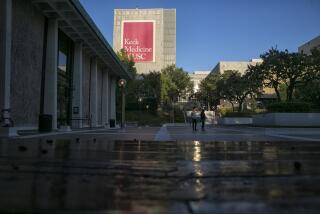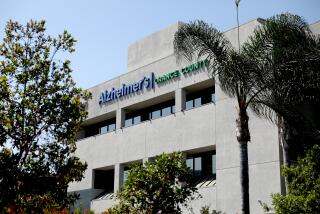Countywide Program to Test Drug Thought to Aid Victims of Stroke : Medicine: San Diego Stroke Treatment Project also hopes to educate public in early warning signs of strokes.
- Share via
Neurologists across San Diego County are banding together to test whether the clot-dissolving drug tPA can help prevent brain damage from strokes.
The San Diego Stroke Treatment Project also will join researchers at UC San Diego with community neurologists, paramedics, and hospitals from North County to San Diego in an effort to get early medical help for suspected stroke victims. A hospital in Sacramento will also be participating.
“Everybody in America knows what it means to have a heart attack, but there are very few adults in the United States who know the warning signs of a stroke,” said Dr. Patrick Lyden. “We intend to change the way people think about stroke in this county, and three years from now I hope to be able to say that a majority of adults know the warning signs of stroke and know that they should call 911.”
The most common type of stroke occurs when the brain is deprived of oxygen because of a blood clot in an artery leading to the brain. Strokes are the third leading cause of death in the United States, after heart attack and cancer. Lyden estimates there are between 4,000 and 5,000 strokes annually in the county.
Funded with $338,000 from the National Institutes of Health, the three-year project is the second phase of a federal research effort on stroke and tPA, tissue plasminogen activator.
The drug is made by the pioneering biotechnology firm Genentech of South San Francisco. Genentech originally promoted tPA as a blood-thinner to prevent damage to the heart muscle after heart attack.
However, it hasn’t come into wide use because recent studies have shown it to be no more useful than a much cheaper alternative, streptokinase. Streptokinase costs about $185 a dose, compared to $2,200 for tPA.
In strokes, though, tPA possibly has an edge over streptokinase because of indications that the latter can cause brain hemorrhaging, Lyden said.
An early test at the University of Cincinnati and the University of Charlottesville concluded that tPA might be useful in preventing brain damage if administered within the first 90 minutes after the stroke occurred. Of 74 patients, 20 made a dramatic, early recovery, 34 made significant recovery in 24 hours and two suffered brain hemorrhaging but did not die.
Another study at medical centers in the United States and Germany found that administering it six to eight hours after the stroke increased the risk of death from brain hemorrhage.
Consequently, patients in the UCSD-headquartered study in San Diego will be given the drug within 90 minutes of their first symptoms, Lyden said.
The San Diego County trial also will have what was lacking in the earlier studies, a placebo control group--half the patients will receive tPA, but half won’t. But, Lyden emphasized, if early results show tPA to be of significant help preventing death or disability from stroke, the trial will be discontinued and the drug offered to everyone.
Lyden noted that, though several community neurologists are participating in the trial, the idea of using tPA is being critically approached.
“Neurologists are appropriately skeptical of tPA until it’s proven to be safe, but those of us who are participating in the study are working together to bring this drug to the people of San Diego and hopefully find out if it is effective and safe.”
Just as important to Lyden as the drug-testing aspect of the program is its educational component.
With more than 450,000 residents of San Diego County older than age 55, stroke is a major health problem here. After age 55, incidence of stroke more than doubles every 10 years, according to the American Heart Assn.
The San Diego portion of the study will seek to enroll at least 26 patients, although more will be included if they can be identified within the 90-minute time frame.
Nationwide, there are an estimated 500,000 strokes every year, about 149,000 of them fatal, according to the association. But the survivors--about 2 million in 1987--can be left with walking, speaking and thinking difficulties because a stroke cuts off oxygen to the brain.
Working with neurologists, media and hospitals, the San Diego Stroke Treatment Project will attempt to train the entire community to recognize the symptoms of stroke, and to act on them. Symptoms include:
* Sudden weakness or numbness of the face, arm and leg on one side of the body. This often happens at night or first thing in the morning, when blood pressure is low.
* Loss of speech or trouble talking or understanding speech.
* Dimness or loss of vision, particularly in only one eye.
* Unexplained dizziness, unsteadiness or sudden falls.
Participating hospitals in the county are Mercy, Scripps Memorial (La Jolla and Encinitas); Sharp Memorial; Tri-City; UCSD; and VA. Also involved is Mercy General Hospital Center in Sacramento. Kaiser hospitals might also participate, Lyden said, but Naval Hospital San Diego will not.
Participating neurologists are Lyden and Drs. James Grisolia, Edward Chaplin, Joel Kunin, Jack Schim, John Rothrock of San Diego County; and Dr. Richard Atkinson of Sacramento. Traci Babcock, a registered nurse, is project coordinator.






